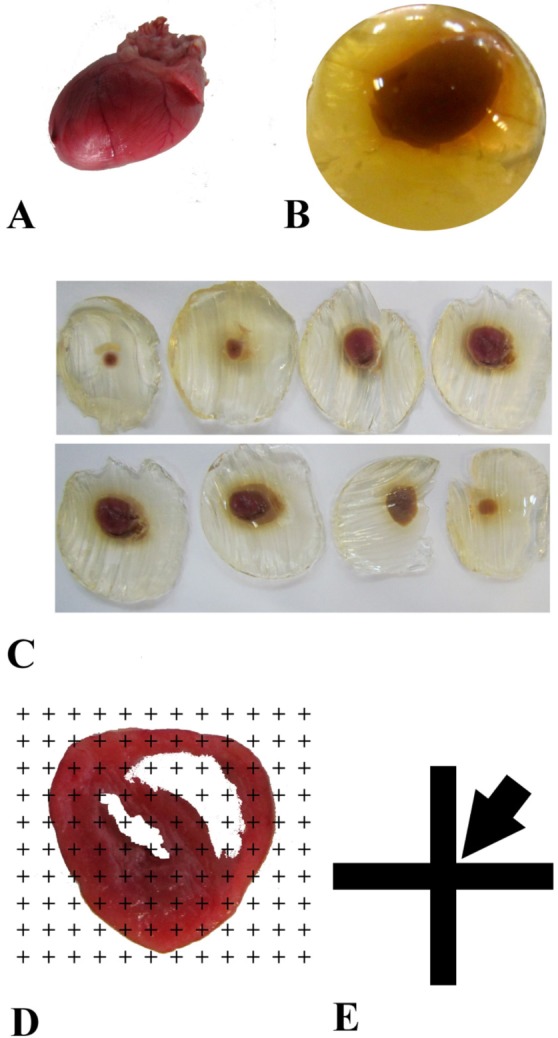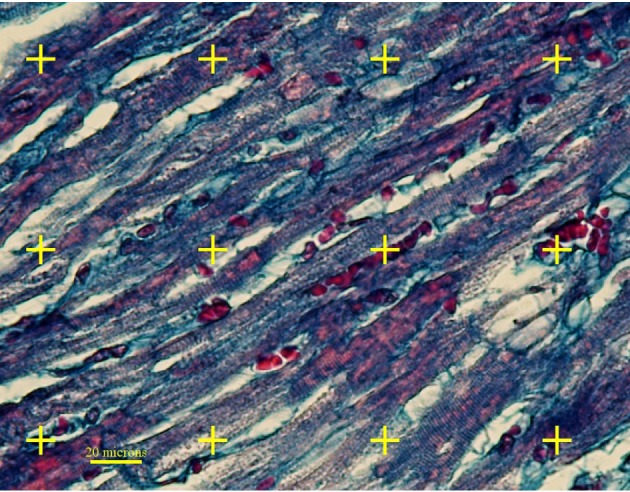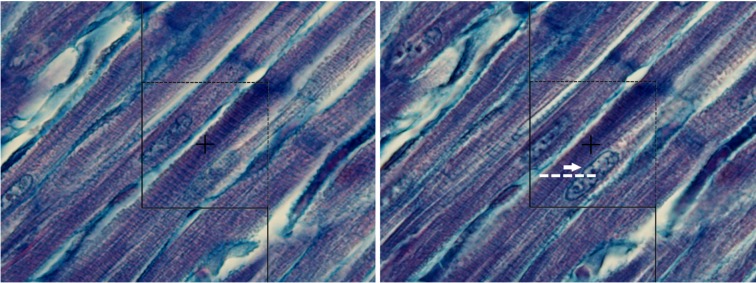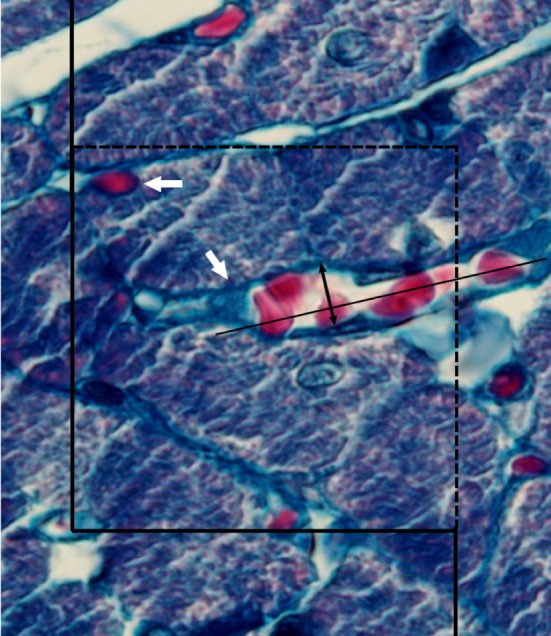Lab Anim Res.
2013 Mar;29(1):12-18. 10.5625/lar.2013.29.1.12.
Stereological study of the diabetic heart of male rats
- Affiliations
-
- 1Histomorphometry & Stereology Research Center, Shiraz University of Medical Sciences, Shiraz, Iran. karbalas@sums.ac.ir
- 2Anatomy Department, Shiraz University of Medical Sciences, Shiraz, Iran.
- 3Pharmacology Department, Shiraz University of Medical Sciences, Shiraz, Iran.
- KMID: 2312098
- DOI: http://doi.org/10.5625/lar.2013.29.1.12
Abstract
- The present study aimed to quantitatively compare the normal and diabetic hearts of rats using stereological methods. Diabetic and control rats received streptozotocin (60 mg/kg) and no treatments, respectively. On the 56th day, the hearts were removed and their total volume was estimated using isotropic Cavalieri method. The total volume of the connective tissues and vessels, total length and diameter of the vessels, total number of cardiomyocytes nuclei, and the mean volume of the cardiomyocytes were estimated, as well. In comparison to the control animals, 60 and 43% increase was observed in the total volume of the connective tissue and microvessels of the diabetic rats, respectively (P<0.05). The percent of the vessel profiles with the diameter of 2-4 microm was decreased, while the percent of the vessel profiles with the diameter of 4.1-8 microm was increased in the diabetic hearts (P<0.05). No significant difference was found in the vessels with more than 8 microm diameters. The total number of the cardiomyocytes' nuclei and the number-weighted mean volume were respectively decreased by 37 and 64% in the diabetic group (P<0.01). A significant difference was observed between the two groups concerning the left ventricle volume to body weight ratio as an index for ventricular hypertrophy (P<0.05), while no difference was found regarding the right ventricle to body weight ratio. It can be concluded that diabetes can induce structural changes, including loss and/or atrophy of the cardiomyocytes, accompanied with increase in the connective tissue in the rats' hearts.
Keyword
MeSH Terms
Figure
Reference
-
1. Cheng YZ, Chen LJ, Lee WJ, Chen MF, Jung Lin H, Cheng JT. Increase of myocardial performance by Rhodiola-ethanol extract in diabetic rats. J Ethnopharmacol. 2012; 144(2):234–239. PMID: 23044195.
Article2. Wang J, Song Y, Wang Q, Kralik PM, Epstein PN. Causes and characteristics of diabetic cardiomyopathy. Rev Diabet Stud. 2006; 3(3):108–117. PMID: 17487334.
Article3. Kannel WB, Hjortland M, Castelli WP. Role of diabetes in congestive heart failure: the Framingham study. Am J Cardiol. 1974; 34(1):29–34. PMID: 4835750.
Article4. Abbott RD, Donahue RP, Kannel WB, Wilson PW. The impact of diabetes on survival following myocardial infarction in men vs women. The Framingham Study. JAMA. 1988; 260(23):3456–3460. PMID: 2974889.
Article5. Rubler S, Dlugash J, Yuceoglu YZ, Kumral T, Branwood AW, Grishman A. New type of cardiomyopathy associated with diabetic glomerulosclerosis. Am J Cardiol. 1972; 30(6):595–602. PMID: 4263660.
Article6. Liu JW, Liu D, Cui KZ, Xu Y, Li YB, Sun YM, Su Y. Recent advances in understanding the biochemical and molecular mechanism of diabetic cardiomyopathy. Biochem Biophys Res Commun. 2012; 427(3):441–443. PMID: 22995317.
Article7. Loganathan R, Bilgen M, Al-Hafez B, Smirnova IV. Characterization of alterations in diabetic myocardial tissue using high resolution MRI. Int J Cardiovasc Imaging. 2006; 22(1):81–90. PMID: 16362172.
Article8. Karbalay-Doust S, Noorafshan A, Pourshahid SM. Taxol and taurine protect the renal tissue of rats after unilateral ureteral obstruction: a stereological survey. Korean J Urol. 2012; 53(5):360–367. PMID: 22670197.
Article9. Noorafshan A, Ebrahimpoor MR, Sadeghi Y. Stereological study of the cells of dorsal root ganglia in male diabetic rats. APMIS. 2001; 109(11):762–766. PMID: 11900055.
Article10. Mühlfeld C, Nyengaard JR, Mayhew TM. A review of state-of-the-art stereology for better quantitative 3D morphology in cardiac research. Cardiovasc Pathol. 2010; 19(2):65–82. PMID: 19144544.
Article11. Nyengaard JR. Stereologic methods and their application in kidney research. J Am Soc Nephrol. 1999; 10(5):1100–1123. PMID: 10232698.
Article12. Gundersen HJ, Bagger P, Bendtsen TF, Evans SM, Korbo L, Marcussen N, Møller A, Nielsen K, Nyengaard JR, Pakkenberg B, et al. The new stereological tools: disector, fractionator, nucleator and point sampled intercepts and their use in pathological research and diagnosis. APMIS. 1988; 96(10):857–881. PMID: 3056461.
Article13. Gundersen HJ, Bendtsen TF, Korbo L, Marcussen N, Møller A, Nielsen K, Nyengaard JR, Pakkenberg B, Sørensen FB, Vesterby A, et al. Some new, simple and efficient stereological methods and their use in pathological research and diagnosis. APMIS. 1988; 96(5):379–394. PMID: 3288247.
Article14. Brüel A, Oxlund H, Nyengaard JR. The total length of myocytes and capillaries, and total number of myocyte nuclei in the rat heart are time-dependently increased by growth hormone. Growth Horm IGF Res. 2005; 15(4):256–264. PMID: 15979915.
Article15. Komaru T, Kanatsuka H, Shirato K. Coronary microcirculation: physiology and pharmacology. Pharmacol Ther. 2000; 86(3):217–261. PMID: 10882810.16. Khazaei M, Fallahzadeh AR, Sharifi MR, Afsharmoghaddam N, Javanmard SH, Salehi E. Effects of diabetes on myocardial capillary density and serum angiogenesis biomarkers in male rats. Clinics (Sao Paulo). 2011; 66(8):1419–1424. PMID: 21915494.
Article17. Fischer M, Wiest G, Tekesin I, Amann K, Mann J, Hasslacher C, Derks H, Mall G. Effects of combined renovascular hypertension and diabetes mellitus on myocardial cells, non-vascular interstitium and capillaries: a stereological study on rat hearts. Virchows Arch A Pathol Anat Histopathol. 1992; 420(6):499–506. PMID: 1609510.
Article18. Soetikno V, Sari FR, Sukumaran V, Lakshmanan AP, Mito S, Harima M, Thandavarayan RA, Suzuki K, Nagata M, Takagi R, Watanabe K. Curcumin prevents diabetic cardiomyopathy in streptozotocin-induced diabetic rats: possible involvement of PKC-MAPK signaling pathway. Eur J Pharm Sci. 2012; 47(3):604–614. PMID: 22564708.
Article19. Mellor KM, Bell JR, Ritchie RH, Delbridge LM. Myocardial insulin resistance, metabolic stress and autophagy in diabetes. Clin Exp Pharmacol Physiol. 2013; 40(1):56–61. PMID: 22804725.
Article20. Lee Y, Hong Y, Lee SR, Chang KT, Hong Y. Autophagy contributes to retardation of cardiac growth in diabetic rats. Lab Anim Res. 2012; 28(2):99–107. PMID: 22787483.
Article21. Kawaguchi M, Asakura T, Saito F, Nemoto O, Maehara K, Miyake K, Sugai N, Maruyama Y. [Changes in diameter size and F-actin expression in the myocytes of patients with diabetes and streptozotocin-induced diabetes model rats]. J Cardiol. 1999; 34(6):333–339. PMID: 10642930.
- Full Text Links
- Actions
-
Cited
- CITED
-
- Close
- Share
- Similar articles
-
- Protective Effects of Ginger (Zingiber officinale) Extract against Diabetes-Induced Heart Abnormality in Rats
- Effects of Polygonatum odoratum on In vivo Insulin Activity in Streptozotocin-Induced Diabetic Rats
- Decrease in Ca2+ storage in the cardiac sarcoplasmic reticulum of diabetic rat
- Proliferation of Cultured Vascular Smooth Muscle Cells(VSMCs) Obtained from Aortas of Insulin Dependent Diabetic Rats
- Stereological study of the effects of morphine consumption and abstinence on the number of the neurons and oligodendrocytes in medial prefrontal cortex of rats






